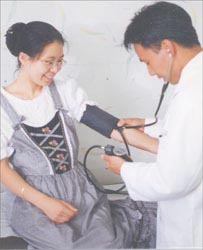산후 진찰, Postpartum physical examination

출산후 의사의 지시에 따라 산후 진찰을 받는다
산후 첫 산후 진찰을 언제쯤 받아야 가장 좋은지 일률적으로 정할 수는 없다. 분만방법, 산모의 건강상태, 경제적 면, 각 의사, 그 외 다른 조건에 따라 다르다.
일반적으로 자연분만을 한 건강한 산모는 분만 후 적어도 4〜6주 경에 첫 산후진찰을 받아야 한다. 그러나 제왕절개 수술분만을 했거나 회음절개 봉합수술을 받았거나 산후에 우울증이나 건강문제가 있으면 산후 4〜6주 전에 병원에 서 검진을 받아야 한다.
산후 건강이 정상적 상태로 돌아가는지 알아보기 위해 진찰을 받는다. 산후 4〜6주 경에 자궁의 크기는 임신 전 자궁의 크기와 거의 비슷하게 되고 자궁의 위치도 본래의 위치로 되돌아간다. 이때 거의 대부분의 산모의 체중도 임신전의 체중으로 되돌아간다.
산후 진찰은 임신 중 받았던 임신진찰과 거의 비슷하다. 체중과 혈압을 재고, 빈혈이 있는지 피검사 등을 한다. 필요에 따라 내진도 받고 유방 진찰도 받는다. 제왕절개 수술 자리도 체크해 보고 어떤 병이 있을 때는 그 병도 이때 적절히 새로 평가해보고 적절한 진단·치료를 받는다.
식사를 잘 하는지 잠을 잘 자는지 소변을 잘 보는지 대변을 잘 보는지 유방에 어떤 문제가 있는지 모유수유를 하면 어떤 문제가 있는지 아기는 어떤지도 알아본다. 그리고 정신적 육체적 문제가 있는지도 알아본다. 이때 상담해서 문제를 풀어본다
첫 산후 진찰을 받을 때 산후 어떤 운동이 좋은지, 어느 정도 신체적 운동을 해도 되는지, 어떤 종류의 산후체조를 할 수 있는지, 집안에서 할 수 있는 일은, 직장에는 언제쯤 나갈 수 있는지, 그밖에 다른 여러 가지 생활양식에 대해서도 알아봐야 한다. 그리고 아기에 관한 질문도 의사에게 할 수 있다.
산후 진찰을 받으러 병원에 가기 전에 질문할 사항을 메모했다가 진찰을 받으러 갈 때 가지고 가서 의사에게 조리 있고 간단하게 질문할 수 있다. 그리고 의사의 지시 사항도 메모하면 후에 참고된다.
첫 산후 진찰을 받으러 병원에 갈 때 가족계획과 피임방법 등에 대해서 질문이 있으면 그것도 문의할 수 있고, 언제쯤 다음 임신을 해야 가장 좋은 지도 알아볼 수 있다.
Copyright ⓒ 2014 John Sangwon Lee, MD., FAAP
Postpartum physical examination 산후 진찰

After childbirth, receive postpartum examination according to your doctor’s
instructions. ![]()
- It is not possible to uniformly decide when the first postpartum examination after childbirth is best. It depends on the delivery method, the mother’s health status, economics, each doctor, and other conditions.
- In general, healthy mothers with natural delivery should receive their first postpartum examination at least 4-6 weeks after delivery.
- However, if you have delivered a cesarean section, have had a perineal repair, or have postpartum depression or health problems, you should get a checkup at the hospital 4-6 weeks before postpartum.
- Seek a doctor to see if your postpartum health is returning to normal. Around 4-6 weeks postpartum, the size of the uterus becomes almost the same as that of the uterus before pregnancy, and the uterus’s position returns to its original position. At this time, most of the mother’s weight also returns to the weight before pregnancy. The postpartum examination is almost the same as the pregnancy examination received during pregnancy.
- Check your weight and blood pressure, and do blood tests for anemia.
- If necessary, receive an earthquake examination and a breast examination.
- The site of the cesarean section is also checked, and if there is any disease, the disease is appropriately reevaluated at this time, and appropriate diagnosis and treatment are received.
- Eating well, sleeping well, peeing well, stooling well, breast problems, breastfeeding, and your baby. Also, look for mental and physical problems.
- At this time, consult and solve the problem. When you first go to the postpartum examination, what kind of exercise is good after giving birth, how much physical exercise you can do, what kind of postpartum gymnastics you can do, what you can do at home when you can go to work, and many other lifestyles.
- You should also find out about it. And you can ask your doctor any questions about your baby.
- Before going to the hospital for a postpartum examination, you can take note of questions to ask and take them with you when you go to the doctor, so you can ask the doctor in a simple and simple way.
- Also, take note of the doctor’s instructions for reference later.
When you go to the hospital for your first postpartum examination, if you have any questions about family planning and contraception, you can also inquire about it, and you can find out when it is best to get pregnant next time. Copyright ⓒ 2014 John Sangwon Lee, MD., FAAP
“부모도 반의사가 되어야 한다”-본 사이트의 내용은 여러분들의 의사로부터 얻은 정보와 진료를 대신할 수 없습니다.
“The information contained in this publication should not be used as a substitute for the medical care and advice of your doctor. There may be variations in treatment that your doctor may recommend based on individual facts and circumstances.
“Parental education is the best medicine.“